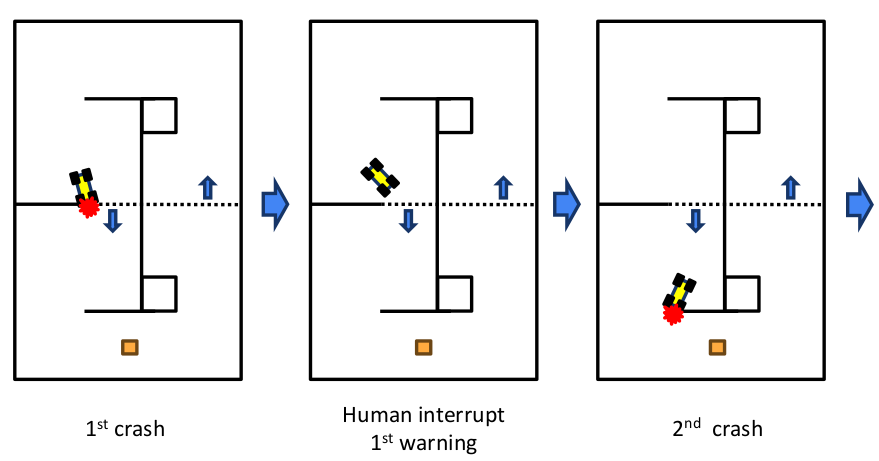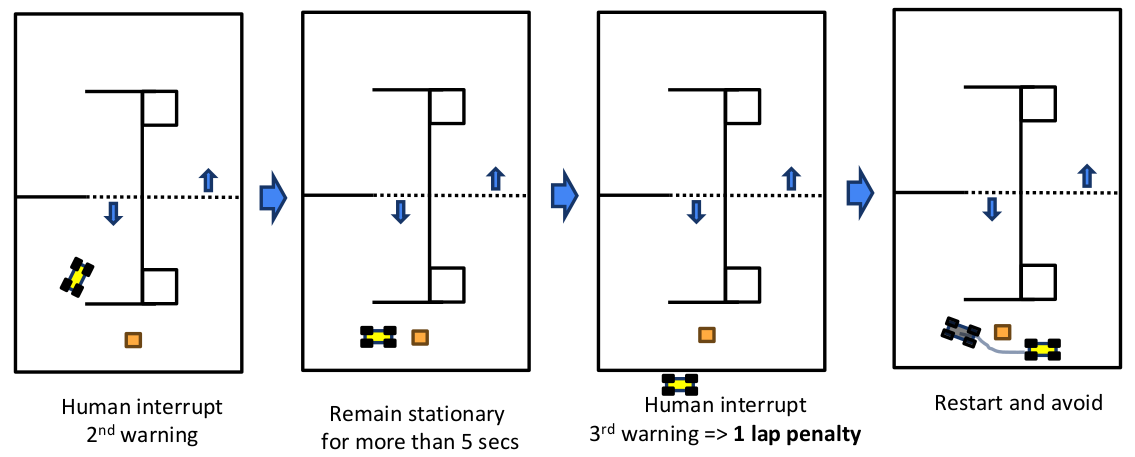ROBORACER GRAND PRIX Rules
Last Updated: 2025-09-28
Table of content
- 1. Overview
- 2. Competition General
- 3. Warnings and Penalties
1. Overview
International ROBORACER Autonomous Racing Competition is a racing competition open to teams of all levels. Competing teams may consist of any number of members; however, each participant should be a member of only one team.
This competition will be held as an in-person competition from August 24th (Monday) to August 27th (Thursday), 2026, at BEXCO in Busan during IFAC 2026 (The International Federation of Automatic Control).
ROBORACER Autonomous Racing Competition Schedule: August 24th (Monday) ~ 27th (Thursday), 2026
Teams can register for the competition through the official website.
2. Competition General
- The competition consists of 5 phases:
- Phase 0: Video submission demonstrating obstacle avoidance capability
- Phase 1: Registration and inspection
- Phase 2: Mapping and practice sessions (mapping, regulated practice, open practice)
- Phase 3: Qualification (time trials)
- Phase 4: Head-to-head race
-
Teams registered for in-person competition must provide and build their own vehicles according to the constraints listed below. Additionally, each team must have a unique vehicle (i.e., one lab cannot register six teams with one vehicle).
- To improve the quality of future ROBORACER competitions, winners of each race are encouraged to open-source their algorithm code under an open-source license in the ROBORACER Autonomous Racing Community repository on Github.
2.0 Video Submission
-
Teams must submit a video demonstrating obstacle avoidance capability before the competition.
-
No specific format is required.
-
The submission must demonstrate the vehicle completing more than two laps on the track while avoiding static or dynamic obstacles.
-
Please adhere to the deadline.
2.1 Vehicle Specifications
Vehicle Specifications only allows vehicles that meet the following constraints:
- Vehicles must be built according to ROBORACER guidelines, but alternative parts may be allowed as long as they comply with regulations. Unclear or ambiguous items must be confirmed in advance with race organizers.
- Each vehicle is inspected as part of qualifying to determine if it meets criteria. If criteria are not met, the vehicle cannot participate.
- The ROBORACER Autonomous Racing Competition emphasizes algorithmic performance. Hardware designed to provide an unfair advantage is strictly prohibited..
- Chassis: The race is designed for 1:10 Traxxas chassis (e.g., TRA74054, TRA6804R). While these chassis are recommended, chassis generally within 15% of Traxxas vehicle dimensions are allowed (238mm ≤ width ≤ 341mm, 454mm ≤ length ≤ 654mm). Both 4WD and 2WD are allowed.
- Tires: No limitations (both sponge and rubber allowed). However, chemical additives are strictly prohibited.
- Main Computing Unit: No limitations on specifications. Only one computing unit may be used.
- LiDAR: No limitations on specifications. Only one LiDAR sensor may be used. 3D LiDAR is allowed for this competition. (Note that expensive 3D LiDAR may be damaged in high-speed racing).
- Camera: Both single cameras (e.g., Logitech C270, Logitech C920, Raspberry Pi Camera Module V2, Arducam) and stereo cameras (e.g., Intel Realsense, ZED) are allowed. Cameras that provide additional information such as detection or VIO results from internal camera processing are not allowed. (Depth information is allowed)
- Motor: No limitations on specifications. Only a single motor may be used in the powertrain.
- Battery: 4s LiPo battery or 3S or lower. Only one 4S battery or lower cell combinations allowed (e.g., 2s + 2s allowed).
- Detection Box: Vehicles must be easily detectable by opponent’s LiDAR. Therefore, vehicles must occupy at least 12×12cm space on all horizontal planes between 10-30cm from the ground.
- Foam Bumper: Bumpers must be soft to minimize damage. These two components (detection box and foam bumper) must be attached when there are two or more vehicles on the track.
- Other Sensors: Other sensors (IMU, encoders, custom electronic speed controllers) are allowed. Indoor GPS sensors (e.g., Marvelmind) are not allowed.
2.2 Track & racing environment
The competition will take place at BEXCO in Busan. The characteristics of the environment where the track will be built are:
TBA
2.3 Inspection
- The purpose of inspection is to verify that autonomous vehicle hardware meets competition requirements and is not dangerous to the environment, opponents, or people.
- Vehicles must be built according to ROBORACER guidelines, but alternative parts may be allowed as long as they comply with regulations.
- Teams must demonstrate the ability to activate emergency brakes through remote human control (but cannot be used for intervention during racing!).
- Vehicle inspection is conducted on the first day of the competition.
- Inspection is performed by race referees.
- Inspection must be completed before time trials and after significant changes to vehicle hardware or algorithms.
2.4 Mapping and Practice
2.4.1 Mapping
- Each team is given approximately 5 minutes.
- This is time when one team can exclusively use the entire track.
- This time can be used not only for mapping but also for data acquisition and practice.
- If you miss your designated time slot, the opportunity is lost and no additional time is provided.
- Each team may prepare and use multiple vehicles on the track.
- Teams without map files are allowed to receive them from neighboring teams, but organizers will not assist with this.
2.4.2 Practice
- Consists of Group practice and Open practice.
- Each team may prepare multiple vehicles, but only one vehicle per team may be on the track.
- Sample obstacles are provided.
- No responsibility is taken for accidents that occur during practice.
- However, teams involved in accidents must explain their algorithms when requested by referees.
2.5 Pit Stop
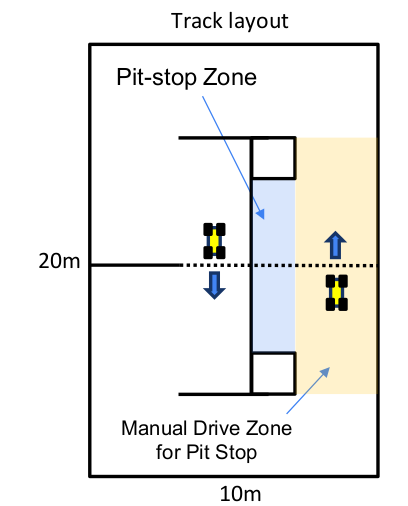
2.5.1 General
- This area is designated for parameter tuning without removing vehicles from the track.
- This area can be used in both qualifying and head-to-head racing.
- When a vehicle is in the pit stop zone, computers (mouse and keyboard) may be used for repositioning and parameter updates.
- As with the general track, people are prohibited from standing in this area.
- Additionally, after safely entering this area, taking out the vehicle to the island for repairs is not regarded as a warning situation.
- Using this area during autonomous racing mode is prohibited.
2.5.1 Entry
- Manual driving can only be used to enter the pit stop zone from the manual driving area.
- Manual driving to enter the pit during head-to-head racing must not harm the opponent’s vehicle.
2.5.2 Exit
- Do not manually drive in any way when exiting from the pit stop zone to the general driving area.
- Vehicles exiting from the pit stop zone to the general driving area have an obligation to protect vehicles in the general driving area.
2.6 Qualifying (Time Trial)
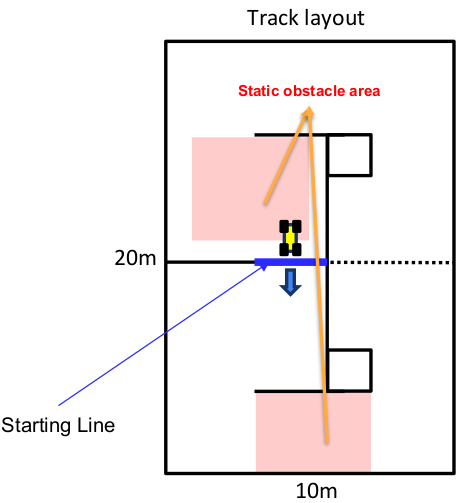
2.6.1 General
- Both practice and qualifying use the same track.
- Conducted for 4 minutes out of the given 6 minutes.
- Qualifying can start anytime within 6 minutes, but 4 minutes is not guaranteed.
- May change depending on total number of participating teams.
2.6.2 Objective
- Fastest lap time
- Maximum number of laps completed without collision
- Two records are ranked separately, then combined to determine final qualifying results.
2.6.3 Static Obstacles
- One static obstacle is randomly placed in each obstacle area.
- Each obstacle is smaller than 0.5m x 0.5m.
- Obstacle positions are announced on the morning of qualifying day and apply equally to all teams.
- Obstacles are removed midway through qualifying time. (e.g., if 4 minutes, removed after 2 minutes)
- Obstacles are safely removed when vehicles are not affected.
2.6.4 Record Invalidation
- Invalidates lap time and resets completed lap count if human intervention affects the vehicle.
- Invalidates lap time and resets completed lap count if contact occurs with static obstacles.
- If contact with track occurs but driving is possible without human intervention, it is considered minor contact and records remain valid.
2.6.5 Precautions
- Taking vehicles to arbitrary positions (e.g., starting line) during qualifying is strictly prohibited.
- If a vehicle is removed from the track and replaced for any reason, the vehicle direction can be slightly adjusted but must be placed back at the position where it exited.
- If track contact occurs, even if records are not invalidated, the track must immediately be returned to its original position.
- If obstacle contact occurs, it must immediately be returned to its original position.
- All computation must be performed inside the vehicle!!
- Data must not be transmitted to vehicles during normal driving.
- Manual (human) emergency brakes are strictly prohibited during normal driving
- There are 2 islands in the track and 2 people can be on one island.
- People will be on islands in the following configuration: (Referee1, Team member1 from Team1), (Referee2, Team member2 from Team1)
2.7 Head-to-Head Racing
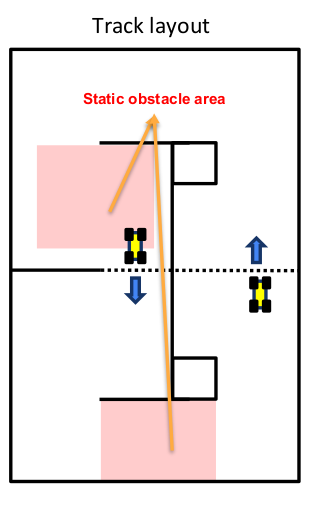
2.7.1 General
- Two vehicles start from different starting lines positioned in opposite directions.
- A total of two static obstacles are used. After all teams complete race preparation, one obstacle is randomly placed in each area.
- Static obstacles on the track are removed sometime after the race starts.
- Each vehicle must complete 20 laps first while avoiding obstacles and opponents within the time limit.
- Racing starts no later than 10 minutes after start preparation begins, regardless of both teams’ readiness.
2.7.2 Objective
- Complete 20 laps first.
2.7.3 Random Static Obstacles
- One static obstacle is randomly placed in each obstacle area.
- Each obstacle is smaller than 0.5m x 0.5m.
- Obstacle positions are determined after both vehicles are ready at their starting lines.
- Only after obstacles are placed can start signals be transmitted to vehicles.
- Obstacles are removed midway through the race.
- Obstacle removal time is (average of best qualifying records of both teams) x 20 / 2.
- Red square areas indicate where static obstacles can be placed.
- Obstacles are safely removed when both vehicles are not affected.
2.7.4 Collisions
- Track boundaries and static obstacles
- Restore track and obstacles
- If racing can continue, it must continue without interruption.
- Vehicle to vehicle
- Do not stop racing at team discretion without referee’s stop signal!!
- If the offending vehicle is clear in a collision situation but fails to overtake, the race continues as is.
- If the victim vehicle is clear in a collision situation and the victim vehicle cannot drive or the collision is serious or gets overtaken, the race is stopped.
2.7.5 Precautions
- Do not stop racing at team discretion without referee’s stop signal!!
- All computation must be performed inside the vehicle!!
- Data must not be transmitted to vehicles during normal driving.
- Manual (human) emergency brakes are strictly prohibited during normal driving
- Vehicles with detection boxes that violate regulations cannot participate in the race.
- There are 2 islands in the track and 2 people can be on one island.
- People will be on islands in the following configuration: (Referee1, Team member from Team1), (Referee2, Team member from Team2)
- Contact and accidents while running side by side will not stop the race if there is no clear offender.
2.8 Common Precautions (Important!!)
- If driving becomes difficult or dangerous due to collision, the vehicle must be emergency stopped immediately.
- All computation must be performed inside the vehicle!!
- Data must not be transmitted to vehicles during normal driving.
- Manual (human) emergency brakes are strictly prohibited during normal driving
- Each team may prepare multiple vehicles, but the only time more than 2 vehicles from the same team can be on the track is during mapping time.
- Sharing one vehicle among multiple teams is strictly prohibited.
- If there can be 2 or more cars on the track, detection boxes must be attached. (e.g., not required for mapping or qualifying)
- No complaints about Wi-Fi will be accepted. Please ensure your autonomous driving system is designed to operate independently regardless of Wi-Fi conditions. We will ask non-racing teams to turn off their Wi-Fi, but this is purely to facilitate team visualization and debugging, not for algorithm performance!
- All hardware repairs and maintenance inside the track (repairing broken components, sensor recalibration, battery replacement, etc.) are prohibited. (Not allowed even in pit stop area)
- Dedicated time for mapping, official practice, and qualifying may vary depending on the number of participating teams.
- Dedicated time for mapping and official practice sessions is assigned on a first-come, first-served basis and only teams that have successfully completed registration and inspection are eligible.
- People are prohibited from being on the track. (Except during mapping time)
- Use of joystick or pressing joystick during racing is not allowed.
- Please change the module for autonomous driving <-> human control switching from “press and hold” method to “on/off” toggle method.
- Only one laptop may be connected for visualization (e.g., RViz) or debugging purposes.
- If space is needed because the vehicle is stopped too close to front obstacles (opponent vehicle or static obstacles) making evasive maneuvers impossible, you can request the referee to move it back slightly.
3. Warnings and Penalties
- Decisions on incidents are at the discretion of on-site referees and must be respected.
- Even incidents with multiple violations only apply one penalty per incident
3.1 Qualifying
3.1.1 One Rank Demotion
- Using keyboard or mouse during racing
- Keyboard and mouse use prohibited even if no data transmission occurs
- Exception 1: When vehicle is not on track
- Exception 2: When on pit stop section
- Exception 3: When transmitting initial guess for re-localization
- Manual manipulation (joystick, keyboard, or other devices) interfering with own vehicle
- Exception 1: When emergency stop is needed due to referee declaring race stoppage
- Exception 2: When transmitting start signal at start/restart
- Exception 3: When emergency stop is needed due to inability to drive from collision
- Exception 4: For manual driving in pit stop manual driving area to enter pit stop section
- Exception 5: When emergency stop is needed after being trapped by obstacles for more than 5 seconds
- Exception 6: When emergency stop is needed to prevent abnormal driving (sudden acceleration, reverse driving, etc.)
- Exception 7: When referee allows manual manipulation because opponent vehicle seriously damaged track making driving impossible
- Exception 8: When stopping after qualifying ends
- During racing, when humans directly generate or select modified paths based on obstacle positions
3.2 Head-to-Head Racing
3.2.1 Additional 1 Lap
- When 3 warnings accumulate
- Human’s fatal interference with opponent vehicle during racing
- When going to fix track causes physical contact with opponent vehicle affecting driving
- When clear offending and victim vehicles exist and victim vehicle becomes unable to drive
- Complete rear collision with large impact accident
- Even if not complete rear collision, accident with large impact
- Using keyboard or mouse during racing
- Keyboard and mouse use prohibited even if no data transmission occurs
- Exception 1: When vehicle is not on track
- Exception 2: When on pit stop section
- Exception 3: When exiting track and re-entering, transmitting initial guess for re-localization
- Manual manipulation (joystick, keyboard, or other devices) interfering with own vehicle
- Exception 1: When emergency stop is needed due to referee declaring race stoppage
- Exception 2: After start, restart, end
- Exception 3: When unable to drive due to collision
- Exception 4: For manual driving in pit stop manual driving area to enter pit stop section
- Exception 5: When stopping for manual manipulation change after being trapped by obstacles for more than 5 seconds
- Exception 6: When emergency stopping to prevent abnormal driving (sudden acceleration, reverse driving, etc.)
- During racing, when humans directly generate or select modified paths based on obstacle positions
3.2.2 Warning 1 Time
- False start
- Not actively restoring track
- Completely crossing pit stop zone in autonomous racing mode
- Detection box not properly secured during race
- Exception 1: When fixed and running in pit stop zone within 1 lap after warning
- New warnings can be given for each lap not properly fixed
- Intervention with own vehicle during racing
- Removing vehicle outside track after collision
- Directly modifying vehicle heading
- Human interference with opponent vehicle during racing
- When going to fix track gets detected by opponent vehicle’s detection module affecting driving
3.2.3 Example Cases
